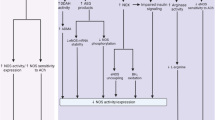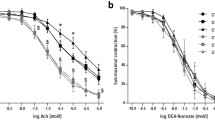Abstract
We hypothesized that maturation-induced vascular inflammation produces endothelial dysfunction in type II diabetes and TNFα plays a key role in triggering inflammation in the development of diabetes. In control (Db/db) mice aged 6, 12, 18 and 24 weeks, sodium nitroprusside (SNP) and acetylcholine (ACh) induced dose-dependent vasodilation, and dilation to ACh was blocked by the NO synthase inhibitor N G-monomethyl-l-arginine. In type II diabetic (db/db) mice at age of 12, 18 and 24 weeks, ACh or flow-induced dilation was blunted compared to Db/db; endothelial function is normal at 6 weeks of age in db/db Vs. control mice, but SNP produced comparable dilation at age of 6, 12, 18 and 24 weeks. Decrements in endothelial function in db/db mice progressively increased from 6–12 to 18–24 weeks. Administration of neutralizing antibodies to TNFα ameliorated endothelial dysfunction in db/db mice aged 12, 18 and 24 weeks. The effect was most prominent in the younger animals. Plasma concentration, expression of TNFα and TNFα receptor 1 (TNFR1) were elevated in coronary arterioles, even at the age of 6 weeks before the development of diabetes in db/db mice compared to control mice. Superoxide production was lower in Db/db mice compared to db/db mice and increments in superoxide production in db/db mice progressively increased from 6–12 to 18–24 weeks. NAD(P)H oxidase inhibitor apocynin attenuated superoxide production in db/db mice at 12 weeks of age, mitochondria respiratory chain inhibitor rotenone attenuated superoxide production at 24 weeks in db/db and Db/db mice, but the combination of apocynin and rotenone reduced superoxide production at 18 weeks for db/db and Db/db mice. The expression of TNFα and its receptors increase progressively with maturation in concert with the development of diabetes. Incremental increases in TNFα/TNFR1 expression induces activation and production of superoxide via NAD(P)H oxidase and/or mitochondria respiratory chain, leading to endothelial dysfunction progressing to the development of type II diabetes.





Similar content being viewed by others
References
Böse D, Leineweber K, Konorza T, Zahn A, Bröcker-Preuss M, Mann K, Haude M, Erbel R, Heusch G (2007) Release of TNF-alpha during stent implantation into saphenous vein aortocoronary bypass grafts and its relation to plaque extrusion and restenosis. Am J Physiol Heart Circ Physiol 292:H2295–H2299
Csiszar A, Labinskyy N, Orosz Z, Ungvari Z (2006) Altered mitochondrial energy metabolism many play a role in vascular aging. Med Hypotheses 67:904–908
Elliott MJ, Maini RN, Feldman AM (1994) Randomised double-blind comparison of chimeric monoclonal antibody to tumour necrosis factor alpha (cA2) versus placebo in rheumatoid arthritis. Lancet 344:1105–1110
Erbel C, Sato K, Meyer FB, Kopecky SL, Frye RL, Goronzy JJ, Weyand CM (2007) Functional profile of activated dendritic cells in unstable atherosclerotic plaque. Basic Res Cardiol 102:123–132
Gao X, Belmadani S, Picchi A, Xu X, Potte BJ, Tewari-Singh N, Capobianco S, Chilian WM, Zhang C (2007) Tumor necrosis factor alpha-induces endothelial dysfunction in Leprdb mice. Circulation 115:245–254
Guzik TJ, Mussa S, Gastaldi D, Sadowsky J, Ratnatunga C, Pillai R, Channon KM (2002) Mechanisms of increased vascular superoxide production in humans diabetes mellitus. Role of NADPH oxidase and endothelial nitric oxide synthase. Circulation 105:1656–1662
Haffner SM, Lehto S, Ronnemaa T (1998) Mortality from coronary heart disease in subjects with type 2 diabetes and in non-diabetic subjects with and without prior myocardial infarction. N Engl J Med 339:229–234
Kadokami T, Frye CS, Lemster BH (2001) Anti-tumor necrosis factor-alpha antibody limits heart failure in a transgenic model. Circulation 104:1094–1097
Kuo L, Davis MJ, Chilian WM (1988) Myogenic activity in isolated subepicardial and subendocardial coronary arterioles. Am J Physiol 255:H1558–H1562
Lattime ECSO (1991) Thymic lymphomas mediate non-MHC-restricted, TNF-dependent lysis of the murine sarcoma WEHI-164. Cell Immunol 136:69–79
Livak KJ, Schmittgen TD (1991) Analysis of relative gene expression data using real-time quantitative PCR and the 2-ΔΔCT method. Methods 25:402–408
Meldrum DM, Cleveland JC, Cain BS (1998) Increased myocardial tumor necrosis factor-α in a crystalloid-perfused model of cardiac ischemia-reperfusion injury. Ann Thorac Surg 65:439–443
Rask-Madsen C, Dominguez H, Ihlemann N (2003) Tumor-necrosis factor-α inhibits insulin’s stimulating effect on glucose uptake and endothelium-dependent vasodilation in humans. Circ Res 203:1815–1821
Schmidt A, Geigenmüller S, Völker W, Buddecke E (2006) The antiatherogenic and antiinflammatory effect of HDL-associated lysosphingolipids operates via Akt –> NF-kappaB signalling pathways in human vascular endothelial cells. Basic Res Cardiol 101:109–116
Skyschally A, Gres P, Hoffmann S, Haude M, Erbel R, Schulz R, Heusch G (2007) Bidirectional role of tumor necrosis factor-alpha in coronary microembolization: progressive contractile dysfunction versus delayed protection against infarction. Circ Res 100:140–146
Soucy KG, Ryoo S, Benjo A, Lim HK, Gupta G, Sohi JS, Elser J, Aon MA, Nyhan D, Shoukas AA, Berkowitz DE (2006) Impaired shear stress-induced nitric oxide production through decreased NOS phosphorylation contributes to age-related vascular stiffness. J Appl Physiol 101:1751–1759
Sun D, Huang A, Yan EH, Wu Z, Yan C, Kaminski P, Oury TD, Wolin MS, Kaley G (2004) Reduced release of nitric oxide to shear stress in mesenteric arteries of aged rats. Am J Physiol Heart Circ Physiol 286:H2249–H2256
Thielmann M, Dörge H, Martin C, Belosjorow S, Schwanke U, van De Sand A, Konietzka I, Büchert A, Krüger A, Schulz R, Heusch G (2002) Myocardial dysfunction with coronary microembolization: signal transduction through a sequence of nitric oxide, tumor necrosis factor-alpha, and sphingosine. Circ Res 90:807–813
Verges B (2004) Clinical interest of PPARs ligands. Diabetes Metab 30:7–12
Wallach D, Varfolomeev EE, Malinin NL (1999) Tumor necrosis factor receptor and Fas signaling mechanisms. Annu Rev Immunol 17:331–367
Westermann D, Van Linthout S, Dhayat S, Dhayat N, Schmidt A, Noutsias M, Song XY, Spillmann F, Riad A, Schultheiss HP, Tschöpe C (2007) Tumor necrosis factor-alpha antagonism protects from myocardial inflammation and fibrosis in experimental diabetic cardiomyopathy. Basic Res Cardiol 102:500–507
Yudkin GS, Stehouwer CD, Emeis JJ (1999) C-reactive protein in healthy subjects: associations with obesity, insulin resistance, and endothelial dysfunction: a potential role for cytokines originating from adipose tissue? Arterioscler Thromb Vasc Biol 19:972–978
Zhang C, Hein TW, Wang W, Ren Y, Shipley RD, Kuo L (2006) Activation of JNK and xanthine oxidase by TNF-α impairs nitric oxide-mediated dilation of coronary arterioles. J Mol Cell Cardiol 40:47–257
Zhang C, Xu X, Potter BJ, Wang W, Kuo L, Michael L, Bagby GJ, Chilian WM (2006) TNF-alpha contributes to endothelial dysfunction in ischemia/reperfusion injury. Arterioscler Thromb Vasc Biol 26:475–480
Zhang DX, Yi FX, Zou AP (2002) Role of ceramide in TNF-α-induced impairment of endothelium-dependent vasorelation in coronary arteries. Am J Physiol Heart Circ Physiol 283:H1758–H1794
Acknowledgments
Funding sources: This study was supported by grants from Pfizer Atorvastatin Research Award (2004-37), American Heart Association Scientist Development Grant (110350047A) and NIH grants (RO1-HL077566 and RO1-HL085119) to Dr. Cuihua Zhang. Conflicts of interest None.
Author information
Authors and Affiliations
Corresponding author
Additional information
Returned for 1. Revision: 12 November 2007 1. Revision received: 23 November 2007
Returned for 2. Revision: 19 December 2007 2. Revision received: 23 December 2007
Returned for 3. Revision: 4 January 2008 3. Revision received: 24 March 2008
Rights and permissions
About this article
Cite this article
Zhang, C., Park, Y., Picchi, A. et al. Maturation-induces endothelial dysfunction via vascular inflammation in diabetic mice. Basic Res Cardiol 103, 407–416 (2008). https://doi.org/10.1007/s00395-008-0725-0
Received:
Accepted:
Published:
Issue Date:
DOI: https://doi.org/10.1007/s00395-008-0725-0




